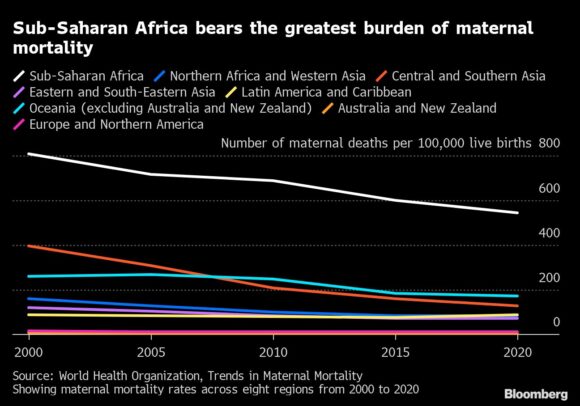Declines in pregnancy- and childbirth-related deaths that took place over a decade and a half have stalled since 2015, as rates increased in some of the world’s wealthiest regions.
Maternal mortality increased by 17% in Europe and North America from 2016 to 2020, and by 15% in Latin America and the Caribbean, according to a World Health Organization report. Worldwide rates flattened over the same period after falling steadily from 2000 through 2015, the report said.
Data from during the pandemic won’t be available for a while, so it will take time to understand the full scope of Covid’s impact.
The greatest burden of maternal deaths still falls on the poorest parts of the world. Of the estimated 287,000 maternal deaths worldwide in 2020, 70% took place in sub-Saharan Africa. In nine countries facing severe humanitarian crises, maternal mortality rates were more than double the global average. These rates are key indicators of how health systems are functioning and highlight the need for immediate investment, said Lale Say, head of the WHO’s unit focused on the integration of sexual and reproductive health with health systems, at a press briefing.
The maternal mortality rate in the US rose from 17 deaths per 100,000 live births in 2015 to 21 deaths in 2020. A separate report published by The Commonwealth Fund in December looked at data from 2018 to 2020 and found that maternal mortality was higher in states that have banned abortion, were planning to ban it, or otherwise restricted it. Those states had fewer maternity care providers and more maternity care “deserts,” defined as counties where these services are limited or absent.
“While there’s an increase in the number of women delivering their babies in health care settings, outcomes are not improving,” Say said. “This shows that we need to increase the quality of care provided.”
Common causes of maternal deaths include severe bleeding, high blood pressure, pregnancy-related infections, complications from unsafe abortion, and underlying conditions that can be aggravated by pregnancy, all of which are largely preventable with access to high-quality health care. About half of health facilities around the world lack access to water and basic hygiene, and about a third of women don’t have four of the eight recommended prenatal checks or receive important postnatal care.
“There needs to be access to quality, respectful care within the facility,” said Jenny Cresswell, a scientist at the WHO. That entails investments in health workers, training, equipment and medication.
Western Regions
The picture in Europe, North America, Latin America, and the Caribbean is mixed, with some countries seeing increases in maternal mortality rates and others seeing decreases.
“Maternal deaths increase when women have less access to quality, timely services, particularly around the time of delivery,” Cresswell said in reference to rising maternal mortality in western regions. “Anything which creates barriers to that — either for the whole population or for subgroups within a population — can lead to increasing maternal mortality rates.”
This includes access to social security or health insurance, racial inequities, and anything that might make a woman less likely to seek care.
Photo credit: Ed Jones/AFP/Getty Images
Topics Trends Europe Pricing Trends
Was this article valuable?
Here are more articles you may enjoy.




 US Home Insurance Still Priced Too Low for Climate Risk, Says Swiss Re Chair
US Home Insurance Still Priced Too Low for Climate Risk, Says Swiss Re Chair  Home Insurance at $10,000 a Year Shows California Buyers’ Pain
Home Insurance at $10,000 a Year Shows California Buyers’ Pain  State Farm Seeking Large Rate Increases in Wildfire-Prone California
State Farm Seeking Large Rate Increases in Wildfire-Prone California  Coverage Needed: Hundreds of Thousands in SE Now in Flood Zones With New Maps
Coverage Needed: Hundreds of Thousands in SE Now in Flood Zones With New Maps 

